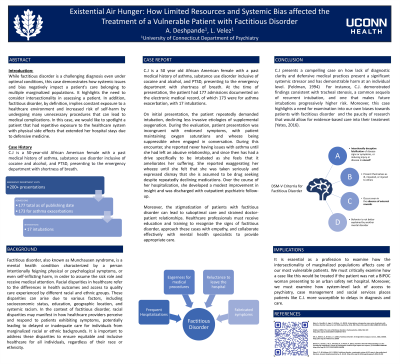Diversity, Equity, and Inclusion
Session: Poster Session
(067) Existential Air Hunger: How Limited Resources and Systemic Bias Affected the Treatment of a Vulnerable Patient with Factitious Disorder

Trainee Involvement: Yes
- AD
Ajit Deshpande, MD
Resident Physician
University of Connecticut Health Center
Farmington, Connecticut, United States - LV
Luis A. Velez, MD
Resident Physician
University of Connecticut Health Center
Hartford, Connecticut, United States
Presenting Author(s)
Co-Author(s)
Background/Significance: While factitious disorder is a challenging diagnosis even under optimal conditions, this case demonstrates how systemic issues and bias negatively impact a patient's care belonging to multiple marginalized populations. It highlights the need to consider intersectionality in assessing a patient. In addition, factitious disorder, by definition, implies constant exposure to a healthcare environment and increased risk of self-harm by undergoing many unnecessary procedures that can lead to medical complications. In this case, we would like to spotlight a patient that had repetitive exposure to the healthcare system with physical side effects that extended her hospital stays due to defensive medicine. C.J is a 50 year old African American female with a past medical history of asthma, substance use disorder inclusive of cocaine and alcohol, and PTSD, presenting to the emergency department with shortness of breath. At the time of presentation, the patient had 177 admissions documented on the electronic medical record, of which 173 were for asthma exacerbation, with 17 intubations. On initial presentation, the patient repeatedly demanded intubation, declining less invasive etiologies of supplemental oxygenation. During the evaluation, patient presentation was incongruent with endorsed symptoms, with patient maintaining oxygen saturation levels and her wheeze being suppressible when engaged in conversation. During this encounter, she reported never having issues with asthma until she had left an abusive relationship, and since then has had a drive specifically to be intubated as she feels that it ameliorates her suffering. She reported exaggerating her wheeze until she felt that she was taken seriously and expressed dismay that she is assumed to be drug seeking despite repeatedly declining medications. Over the course of her hospitalization, she developed a modest improvement in insight and was discharged with outpatient psychiatric follow-up. C.J presents a compelling case on how lack of diagnostic clarity and defensive medical practices present a significant systemic stressor and has demonstrable harm at an individual level. (Feldman, 1994) For instance, C.J. demonstrated findings consistent with tracheal stenosis, a common sequela of recurrent intubation, and one that makes future intubations progressively higher risk. Moreover, this case highlights a need for examination into our own biases towards patients with factitious disorder and the paucity of research that would allow for evidence based care into their treatment (Yates, 2016). Conclusions/Implications: It is essential as a profession to examine how the intersectionality of marginalized populations affects care of our most vulnerable patients. We must critically examine how a case like this would be treated if the patient was not a BIPOC woman presenting to an urban safety net hospital. Moreover, we must examine how system-level lack of access to psychiatry, case management and social services places patients like C.J. more susceptible to delays in diagnosis and care. 2. Yates GP, Feldman MD. Factitious disorder: a systematic review of 455 cases in the professional literature. Gen Hosp Psychiatry. 2016 Jul-Aug;41:20-8.
Case:
Discussion:
References:
1. Feldman The costs of factitious disorders. Psychosomatics. 1994 Sep-Oct;35(5):506-7.

